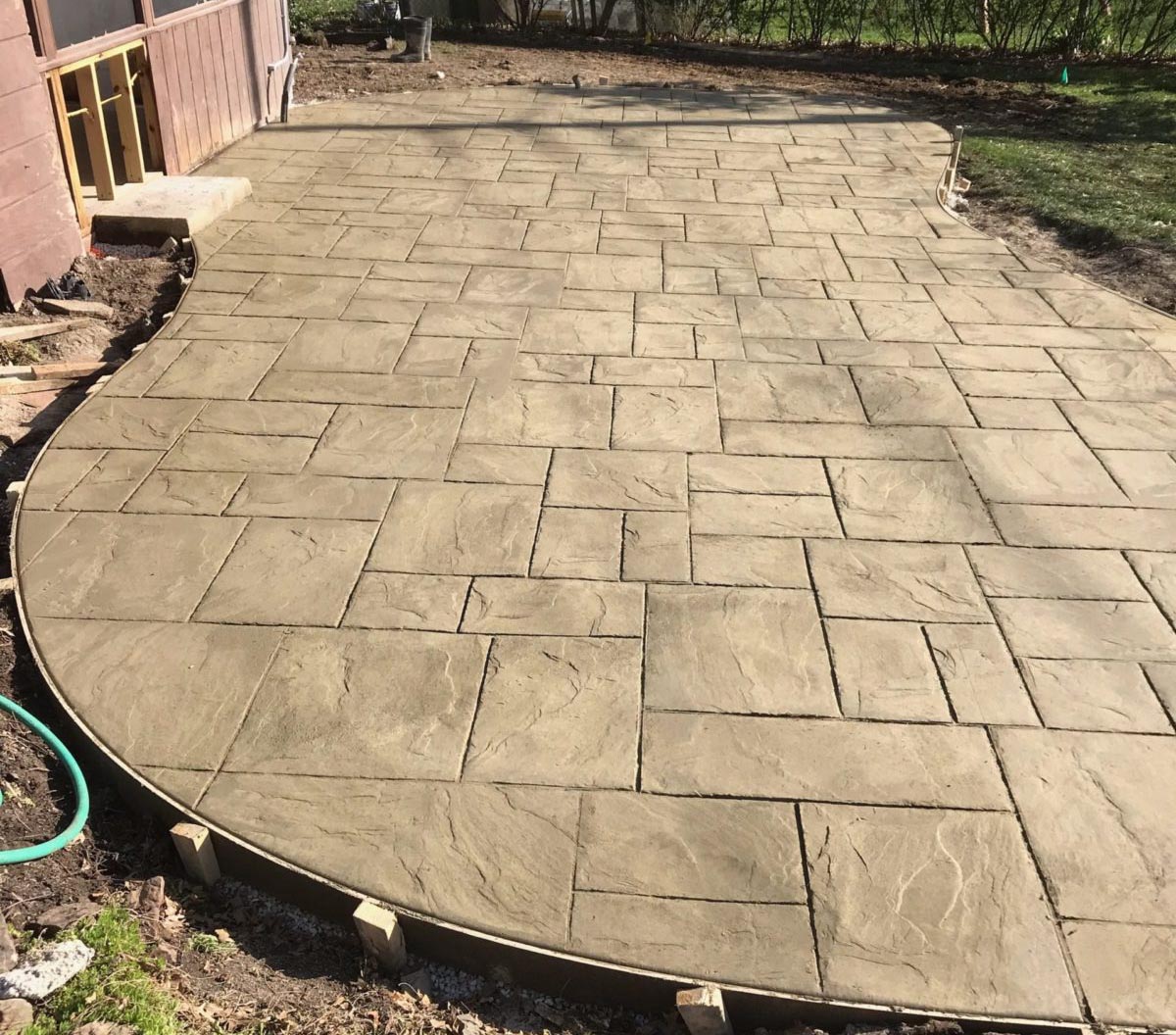Stamped Concrete Colorado Springs offers a versatile design solution that fits in well with your home. It can reduce the fire hazard around combustible outdoor appliances and complement your garden, pool, or landscaping.
Hiring professionals is often cost-effective compared to DIY projects, as tools like stamps and concrete mixes can be expensive. Also, proper curing and sealing of the finished surface is essential to prevent damage from exposure to harsh weather conditions.

Whether you choose a stamped concrete pattern that mimics the look of stone, wood, brick, cobblestones, tile, or even old-world style flooring, color plays a big role in your final results. With high-quality stamping mats,* available in a wide range of textures and designs, creating natural-looking color variation is easy. This is possible using an integral and surface color hardener broadcast during finishing.
There are two ways to apply the base color to stamped concrete: Integral Color is mixed directly into the concrete before it is poured. This gives you a richer, more consistent color throughout the project. It also means that if chips happen during the pour, the white concrete will be visible, making it easier to repair.
The other way is to use a Surface Color Hardener, which is applied as a powder once the concrete is poured. This gives you more options for color, but it can be messier and produce more dust. It is still relatively easy to work with and cleans up very quickly.
Generally, homeowners choose colors that complement other elements of their landscaping and home. Earth tones are very popular, from grays and tans to red tones such as terra-cotta and mahogany. Other choices include shades of blue and green for a more contemporary look or charcoal and black tones for a dramatic impact.
Once you’ve decided on the overall design, the choice of color becomes much more personal. If you are going for a more rustic or natural look, using multiple colors in the same project is often recommended to create a more realistic finish. This will help the concrete look more like the material it is imitating, and it can also enhance the texture of the surface.
The most common way to add color to stamped concrete is to broadcast a release powder over it once it is poured. This can be done in various color combinations, usually used to highlight or accent the design being stamped into the concrete.
Compared to other paving materials like stone, slate, or wood, stamped concrete is less expensive and offers more flexibility in design. In addition, it is more practical than these other materials as it does not require grout lines and will not rot or splinter. This textured and colored concrete is typically created using stamped concrete mats that produce various imprinted patterns and textures.
Many of the colors used in stamped concrete are earth tones that mimic the natural building materials intended to imitate. These colors include browns and tans, grays and charcoals, and redder tones like terra cotta. These shades are often combined to create more vibrant and contrasting color options.
A specialized release agent must be applied to the concrete surface to produce realistic and varied texture in stamped concrete. This can be done in one of two ways – through a powdered or spray-on color release. The cast-on color release comprises calcium-releasing powders that repel water, while the spray-on color release is a light aromatic-based solvent.
Once the base color and release agent are applied, the stamped concrete can be pressed into place with concrete stamps that match the desired pattern. This step is important to ensure the finished product looks uniform and professional. In some cases, a concrete retarder can slow the set time of the concrete slab in the area where the stamps are being placed so that the concrete has sufficient time to bind with the new surface and create a durable bond.
Once the stamped concrete has been shaped and colored, it must be sealed to preserve its appearance and longevity. A reputable contractor can advise you on your project’s best sealant. Butterfield Color offers a premium line of curing and sealing products called Clear Guard® Cure & Seal, designed specifically for decorative concrete applications. To keep your fixed and sealed concrete looking its best, periodic inspections will be necessary to identify any damage or areas that need attention and repair.
Stamped concrete can be textured and colored to mimic the look of stone, wood, brick, or tiles. The flexibility of stamped concrete allows you to create an outdoor space that is unique and that fits perfectly with your home or business.
Many factors determine the cost of your stamped concrete project. The overall size of the area to be covered and the complexity of the pattern are important considerations. Hiring a professional is usually the best option to ensure the job is completed correctly and promptly.
Before you begin stamping, it is important to apply a layer of our Tru Impression Liquid Release product evenly across the surface of your concrete stamps. This will prevent the concrete from sticking to the stamps and creating uneven results. After applying a release layer, carefully align your concrete stamps to match your desired design. When laying out the stamps, make sure to overlap the edges of each one by 4 to 6 inches.
After you have laid out the stamps, carefully press them onto the concrete, using firm but consistent pressure. Once the concrete is stamped, tamp down the skins with appropriate tamping tools. Be careful not to walk on the concrete with your heels or the balls of your feet, as this can cause unwanted impressions in your finished concrete.
Once the concrete is tamped, allow it to dry for a few hours before applying your color. Follow the instructions provided by your concrete contractor for the best results. Once the concrete has dried, you can use a blower to clear away any dust or debris from the finish and wash off any remaining liquid-release products.
If you have any questions about the concrete coloring process, don’t hesitate to contact your local distributor or Butterfield Color. They can provide you with more information about base colors, release colors, washing, cutting, and maintenance.
As with any construction, a few risks are associated with stamped concrete. For example, if the concrete isn’t installed properly or if it is not finished promptly, it may crack. This cannot be easy to fix, so hiring a professional to complete the work is always best. In addition, the concrete is prone to heaving and expanding in cold weather, which can also lead to cracking over time. This is less of a problem with pavers and slabs, which have regular seams to accommodate movement.
The glamorous appearance of stamped concrete can last a long time if it is maintained properly. However, like any other exterior surface, it will need periodic cleaning and resealing.
Using a garden hose on a low setting to spray down the surface of a stamped concrete patio or driveway can remove dirt and grime without damaging it. If you prefer, a mild liquid cleaner can be used. Just be sure to follow the manufacturer’s instructions. Please avoid using power washers on stamped concrete, which can damage the surface.
Staining from oil and grease can also mar the beauty of a stamped concrete surface. If you notice any stains, try cleaning them as soon as possible before they can set in. Liquid dish soap or an alkaline degreaser should work well on most stains. Just test the cleaner on a small area first and follow the manufacturer’s instructions.
Another way to keep your stamped concrete looking its best is by resealing the surface every two years. A sealant will protect the concrete from abrasion and water penetration, and it will help to prevent stains as well. A good quality concrete sealer should last at least two to three years, although harsh winters or scorching summers can speed up deterioration.
A good resealing will restore the shine and color of your stamped concrete and make it easier to clean. Follow the manufacturer’s instructions for applying the sealer, and allow it to dry completely before using the area.
Training your pets not to relieve themselves on the stamped concrete is also a good idea, as their urine contains acids that can damage the concrete. Finally, by installing a shade structure over the concrete, you can reduce the impact of harsh UV rays on its color. While the initial investment of a shade structure may be more expensive than an asphalt or brick surface, protecting your stamped concrete from the effects of sun exposure will save you money in the long run.
